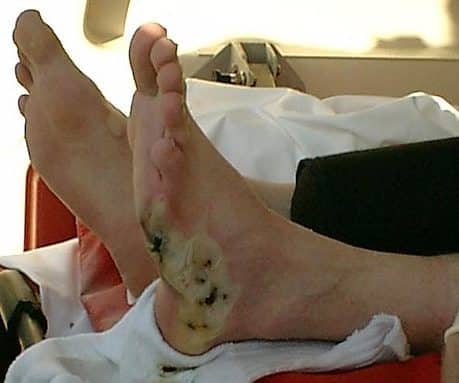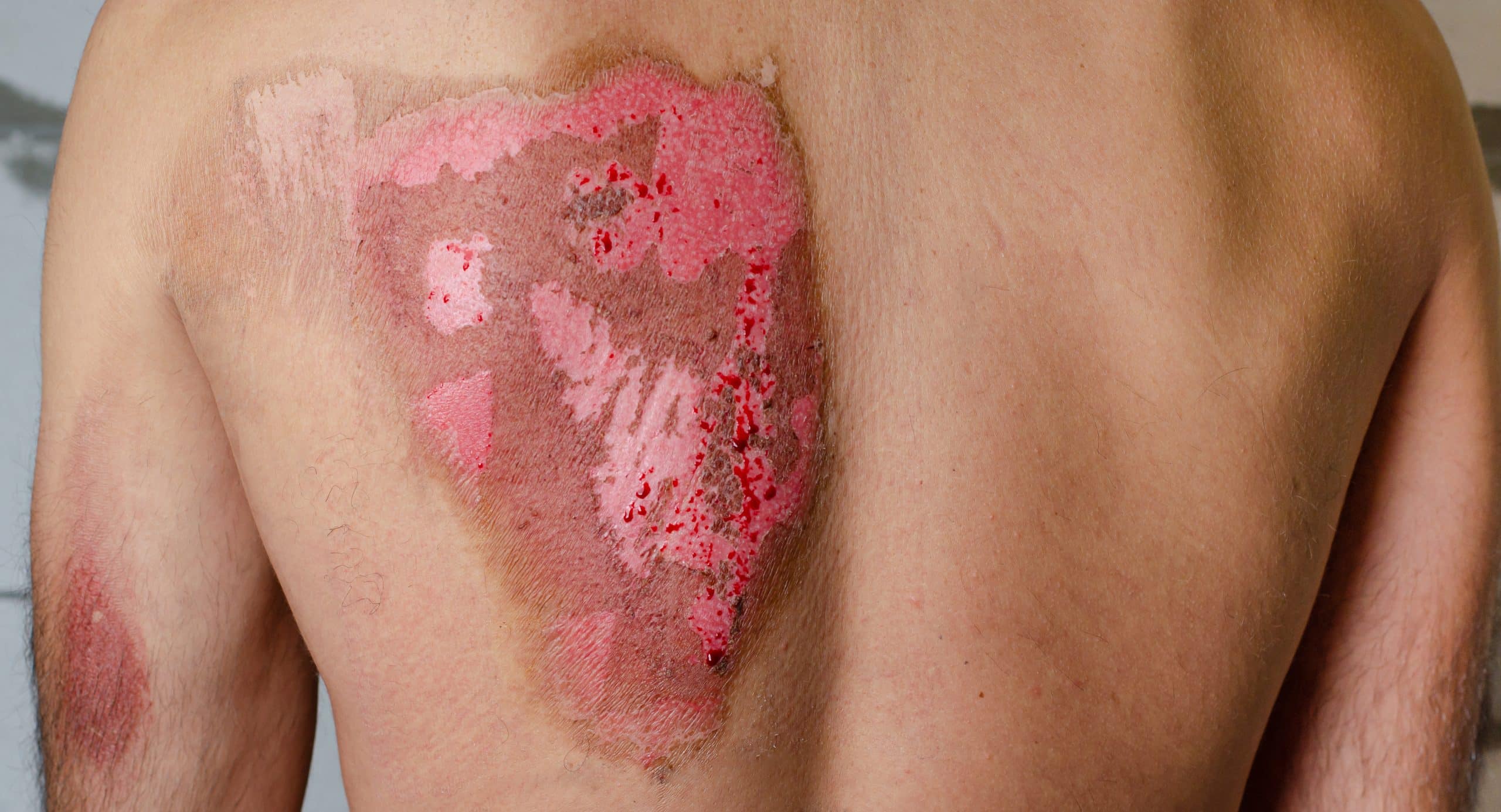Introduction
Burn injuries can have devastating sequelae that can cause long term morbidity, even when the initial challenges have been overcome.
Initial assessment and management of burns should follow core resuscitation principles (further discussed here). This article will discuss burns complications, rehabilitation, and reconstruction, and the specific management of chemical burns, electrical burns, cold injury and burn-like condition.
Complications of Burns
The best way to minimise complications is to manage burns in a dedicated burns centre with immediate full multi-disciplinary involvement.
However, despite advances in treatment, local and systemic complications following burns are still common. Complications can be early or long-term, and local or systemic.
Systemic Complications
Systemic effects will typically manifest in patients with burns of >25% TBSA (or often smaller proportions in children).
Systemic complications will arise secondary to the large inflammatory response produced by the body as a result of the burn injury. Termed Systemic Inflammatory Response Syndrome (SIRS), an exaggerated and dysregulated inflammatory response to injury occurs, leading to third space losses, hypotension, and organ dysfunction.
Further deterioration* can occur in patients developing multiple organ dysfunction syndrome (MODS), whereby the dysregulated systemic inflammatory following the injury leads to end-organ failure. The risk of developing MODS increases with the degree and severity of the burn, as well as increasing patient age.
Treatment is supportive and ensuring adequate and careful fluid resuscitation is performed.
*This can further be complicated by superimposed infection from the body’s impaired immune response, including toxic shock syndrome, usually secondary to S. aureus or Group A streptococcus
Specific organ injuries that can occur include:
- Acute lung injury – caused by a combination of burn and smoke inhalation, which can eventually lead to acute respiratory distress syndrome (ARDS)
- Acute kidney injury – multifactorial from a combination of SIRS, hypotension, myoglobinuria, and any iatrogenic nephrotoxic agents
- Treatment remains supportive, with careful fluid management; mannitol can be used in severe cases, especially with myoglobinuria
- Endocrine complications – Direct fluid loss from the burns, third space losses, and kidney injury can lead to electrolyte imbalance, commonly results in initial hypernatraemia; subsequent hypokalaemia, hypomagnesaemia, hypocalcaemia, and hypophosphataemia
- Gastrointestinal complications – these include paralytic ileus, Curling’s ulcer (see below), and bacterial translocation
- Early enteral feeding often mitigates complications, aiming to maintain body weight and endocrine homeostasis
Curling’s Ulcer
A Curling’s ulcer is a gastric ulcer that can occur following severe burns. The significant reduction in plasma volume following the injury can lead to gastric mucosa ischaemia, leading to ulcer formation
Patients admitted with severe burns who subsequently develop features of upper GI bleeding or perforation should be suspected to have a Curling’s ulcer. Indeed, any patient with significant burn injury should be started on PPI-therapy at admission to reduce this risk.
Local Complications
Adverse scarring (including hypertrophy or keloid growth) and contractures (Fig.2) can result from healing of deep burns.
Contractures are abnormal contraction or stiffening of tissues, resulting in decreased movement and range of motion; they can be intrinsic (from scarring within the affected area) or extrinsic (scarring outside the affected area).
Rehabilitation and Reconstruction
The rehabilitation of the burn patient begins in the acute phase with early focus on long term treatment goals and prevention or minimisation of complications.
Burns centres work as a multi-disciplinary team with physiotherapy, occupational therapy, dieticians, pharmacists and psychologists involved from admission, as well as the anaesthetists, plastic surgeons and specialist nurses.
The goals of rehabilitation and reconstruction are
- Prevention of complications
- Rehabilitation, starting as early as possible
- Reconstruction, to improve function, comfort, and cosmesis
Reconstruction
Prospective scar management begins with early excision and grafting in the initial phase to prevent post-burn hypertrophic scarring and contracture. Thick sheet grafts can be used for important areas, such as the face, hands, and neck; pressure garments, including face masks, are applied as soon as scars are stable*.
For formed scars and contractures, surgery is not attempted until such scars have matured, however intervention may be necessary for evolving complications, such as eyelid contractures or contractures causing nerve compression. Techniques include excision and grafting, scar release and joint release, local and regional flaps, skin substitutes, and tissue expansion.
Non-surgical techniques for scar management include intralesional corticosteroid injection, cryotherapy, laser treatment, radiotherapy and 5-fluorouracil.
Physiotherapy has a key role in maintaining range of motion, preventing abnormal positioning, and preventing predictable contractures. Regular chest physiotherapy is used to minimise pulmonary complications and nutritional support is provided to maintain bodyweight and prevent loss of lean muscle mass.
*Pressure is thought to cause increased apoptosis within the scar, and decrease blood supply limiting collagen synthesis.
Specific Types of Burn
Chemical Burns
Chemical burns can occur from various agents including acids, alkalis, and other substances*. They cause continuous tissue destruction through mechanisms such as oxidation, reduction, and desiccation, until the chemical is neutralised (Fig. 3).
The most important initial management strategy is thorough and immediate irrigation of the affected area, using warm water for at least 30 minutes (ideally longer for alkaline or for eye exposure). Clothes, including shoes and any accessories, that have been contaminated must be removed. The use of buffer or neutralising agents are not recommended.
*Alkaline substances are often quotes as more likely to cause extensive damage, due to their ability to penetrate deeply into tissues and cause liquefactive necrosis, whereas acidic substances will cause a coagulative necrosis

Figure 3 – Hydrofluoric acid burn injury
Electrical Burns
Large electrical burns are most commonly caused by lightning strikes or contact with high-voltage power lines; they can classified as low voltage (<1000V – household supply) or high voltage (>1000V – industrial). All such entries will have an entry and exit wounds, albeit often small, and the damage caused is often more serious than it visually appears.
The main concerns with these injuries are a risk of arrhythmia and myoglobinuria, which can occur even with low voltage burns. Electricity will travel through the path of least resistance, which can include the cardiac conduction system (resulting in arrhythmias), soft tissues (causing extensive rhabomyolysis), or the brain (resulting in seizures or respiratory arrest)
As such, all patients with electrical burns, alongside the standard A to E assessment, need to have an electrocardiogram (ECG) to check for conduction abnormalities. Ensure to also check renal function and creatinine kinase (CK) levels to assess for any rhabdomyolysis or its sequela.
Contractures of the extremity may occur long term, if there was extensive soft tissue damage resulting in scarring and fibrosis of the affected area. Early fasciotomies may be required.

Figure 4 – A second degree burn following an accident on a power line
Cold Injury
Cold injury is classified as freezing (frostbite) or non-freezing (trench foot)
In frostbite, tissues are injured due to cellular and microvascular damage, secondary to the formation of ice crystals within the cells and the extracellular space (Fig. 5). As such, patients presenting with suspected frostbite need prompt management in order to decrease tissue damage
Wet clothing should be removed, as restricts vascular perfusion, and should be replaced by dry blankets; do not massage or rub the affected area. Rewarming needs to be gradual in order to avoid reperfusion injury; the affected extremity needs to be placed in a circulating water bath of 37-39oc, until the tissues soften and become a red/purple colour
If the patient also has hypothermia, rewarming needs to happen at a systemic level. For profound hypothermia (<32 degrees) should be managed with warmed intravenous fluids (rarely bowel irrigation or cardio-pulmonary bypass may be attempted).
Reperfusion is a very painful process; therefore, the patient must have intravenous analgesia administered. The affected area should be demarcated to determine injury progression (dead tissue might need surgical debridement) and tetanus prophylaxis should be given if required.

Figure 5 – A patient suffering from frostbite in both feet
Trench Foot
Non-freezing cold injury (aka ‘trench foot’, ‘immersion foot’) commonly affects the feet, when a near-freezing and wet environment, gravitational stasis and constriction from shoes combine to cause a superficial liquefactive necrosis.
Treatment involves washing, air-drying, rewarming, elevating and resting the feet, to prevent progression to gangrene. It can take up to six months to recover and there may be persistent cold insensitivity.
Key Points
- Burn injuries can have devastating sequelae that can cause long term morbidity
- Complications following burns can be either local and systemic
- Specific types of burn include chemical burns, electrical burns, or cold injury
- The goals of rehabilitation and reconstruction are prevention of complications, rehabilitation, and reconstruction
Burn-Like Conditions
Burn units will also manage certain skin loss conditions, such as toxic epidermal necrolyis (TEN) and staphylococcal scalded skin syndrome (SSSS).
TEN is a rare condition*, whereby an immune-mediated process results in a sheet-like loss of skin and mucosa. It has been associated with drugs (allopurinol, anticonvulsants, antibiotics, NSAIDS), mycoplasma infection and vaccination. In the immediate phase, there is a detachment of the skin at the epidermal/dermal junction with mild shearing force, then later full epidermal and mucosal detachment involving >35% TBSA. Treatment involves stopping the causative agent, dressings and supportive care.
SSSS is a condition that predominantly affects young children, particularly neonates. The skin becomes erythematous and blistered, like a scald, due to exfoliative staphylococcal exotoxins that affect protein complexes that bind epidermal cells together. Treatment is anti-staphylococcal antibiotics and supportive care.
*A milder form is Stephens Johnson syndrome which involves 10% – 35% TBSA


